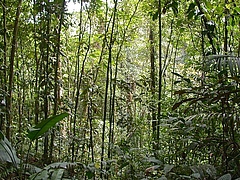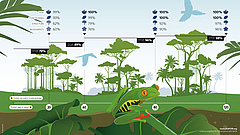Let tropical forests grow again

Relatively young secondary forest in Costa Rica with similar-sized slender stems. (Picture: Robin Chazdon)

Infographic, showing the recovery of tropical forests over time. The forests regrow naturally on abandoned agricultural lands. Four groups of forest characteristics are shown, related to soil, ecosystem functioning (leaf), forest structure (tree) and tree biodiversity (flower). Average percentage of recovery (compared to old-growth forests) after 20, 40, 80, and 120 years is shown for each forest attribute (%) and for the 4 groups of attributes combined (horizontal lines).
The attributes were soils (bulk density, carbon, and nitrogen), ecosystem functioning (community nitrogen fixers, wood density, and specific leaf area), forest structure (aboveground biomass, maximum tree diameter, and structural heterogeneity), and diversity and composition (Picture: Erik Flokstra, Pixels&inkt)
Natural restoration of tropical forests provide large short-term benefits for climate change mitigation and biodiversity conservation
Based on a media release by Wageningen University
Wageningen/Leipzig. Tropical forests are vanishing at an alarming rate through deforestation, but also have the potential to regrow naturally on abandoned lands. A study published this week in Science shows that regrowing tropical forests recover surprisingly fast. After 20 years, characteristic attributes have recovered by an average of nearly 80% of old-growth forest values. This applies e.g. to soil fertility, soil carbon storage, tree diversity, plant functioning and forest structure. The study led by Wageningen University with support from the German Centre for Integrative Biodiversity Research (iDiv) concludes that natural regeneration is a low-cost, nature-based solution for climate change mitigation, biodiversity conservation, and ecosystem restoration.
The international team of tropical ecologists analysed how twelve attributes recover during the natural process of forest regeneration, and how their recovery is interrelated using 77 landscapes and more than 2200 forest plots across tropical America and West Africa.
Lead author Prof Lourens Poorter from Wageningen University says: “While it is essential to actively protect old-growth forests and stop further deforestation, tropical forests have the potential to regrow naturally in already deforested areas on abandoned lands. These regrowing forests cover vast areas and can contribute to local and global targets for ecosystem restoration. They provide global benefits for climate change mitigation and adaptation and biodiversity conservation, and many other services for local people, such as water, fuel, wood, and non-timber forest products”.
The researchers found that these secondary forests recover surprisingly fast, indicating that there are large short-term benefits of natural tropical forest restoration. Yet, the speed of recovery differs strongly across forest attributes: Recovery to 90% of old-growth forest values is fastest for soil fertility (less than 10 years) and for plant functioning (less than 25 years), intermediate for structure and species diversity (25-60 years), and slowest for aboveground biomass and species composition (more than 120 years).
Second author, Dr Dylan Craven, a former researcher at iDiv and Helmholtz Centre for Environmental Research (UFZ), now at Universidad Mayor in Chile, says: “We analysed how the recovery of different forest attributes was interrelated. We found that maximum tree size, variation in forest structure, and tree species richness are robust indicators of recovery of multiple forest attributes. These three indicators are relatively easy to measure and can be used to monitor forest restoration. You can now already monitor tree size and variation over large areas and time scales, using remote sensing.”
Secondary forests are forests that regrow naturally after nearly complete removal of forest cover for anthropogenic use (usually for shifting cultivation, conventional cropping or cattle ranching). In tropical Latin America, secondary forests cover as much as 28% of the land area.
”Given the local and global importance of secondary forests and their rapid recovery after 20 years, we encourage adoption of (assisted) natural regeneration as a low-cost, nature-based solution,” says co-author Dr Nadja Rüger from iDiv and Leipzig University. This could be a simple but efficient measure to meet the goals of the United Nations’ sustainable development, the UN decade of Ecosystem Restoration (2020-2030), UN framework on climate change mitigation (COP 26), and the Convention of Biological Diversity (COP 15).
Bruno Hérault, last author from CIRAD, Ivory Coast adds: “Yet, there is no silver bullet to restoration, and a mix of natural and active restoration may be needed. There is a whole gradient of solutions, ranging from natural regeneration, assisted natural regeneration, agroforestry, to plantations. The optimal solution depends on local site conditions, the local people, and their needs. By using such a mix of approaches we can create more natural, biodiverse, and resilient landscapes.”
This research was financed, amongst others, by the European Research Council Advanced Grant PANTROP and by Deutsche Forschungsgemeinschaft (DFG; FZT-118). It is a product of the sDiv working group sUCCESS. iDiv’s synthesis centre sDiv supports working group meetings where international scientists work together on scientific issues.
Original publication:
(Scientists and alumni with iDiv affiliation bold)
Lourens Poorter, Dylan Craven, Catarina C. Jakovac, Masha T. van der Sande, Lucy Amissah, Frans Bongers, Robin L. Chazdon, Caroline E. Farrior, Stephan Kambach, Jorge A. Meave, Rodrigo Muñoz, Natalia Norden, Nadja Rüger, Michiel van Breugel, Angélica María Almeyda Zambrano, Bienvenu Amani, José Luis Andrade, Pedro H. S. Brancalion, Eben N. Broadbent, Hubert de Foresta, Daisy H. Dent, Géraldine Derroire, Saara J. DeWalt, Juan M. Dupuy, Sandra M. Durán, Alfredo C. Fantini, Bryan Finegan, Alma Hernández-Jaramillo, José Luis Hernández-Stefanoni, Peter Hietz, André B. Junqueira, Justin Kassi N'dja, Susan G. Letcher, Madelon Lohbeck, René López-Camacho, Miguel Martínez-Ramos, Felipe P. L. Melo, Francisco Mora, Sandra C. Müller, Anny E. N'Guessan, Florian Oberleitner, Edgar Ortiz-Malavassi, Eduardo A. Pérez-García, Bruno X. Pinho, Daniel Piotto, Jennifer S. Powers, Susana Rodríguez-Buriticá, Danaë M. A. Rozendaal, Jorge Ruíz, Marcelo Tabarelli, Heitor Mancini Teixeira, Everardo Valadares de Sá Barretto Sampaio, Hans van der Wal, Pedro M. Villa, Geraldo W. Fernandes, Braulio A. Santos, José Aguilar-Cano, Jarcilene S. de Almeida-Cortez, Esteban Alvarez-Davila, Felipe Arreola-Villa, Patricia Balvanera, Justin M. Becknell, George A.L. Cabral, Carolina Castellanos-Castro, Ben H. J. de Jong, Jhon Edison Nieto, Mário M. Espírito-Santo, Maria C. Fandino, Hernando García, Daniel García-Villalobos, Jefferson S. Hall, Alvaro Idárraga, Jaider Jiménez-Montoya, Deborah Kennard, Erika Marín-Spiotta, Rita Mesquita, Yule R. F. Nunes, Susana Ochoa-Gaona, Marielos Peña-Claros, Nathalia Pérez-Cárdenas, Jorge Rodríguez-Velázquez, Lucía Sanaphre-Villanueva, Naomi B. Schwartz, Marc K. Steininger, Maria D.M. Veloso, Henricus F. M. Vester, Ima C. G. Vieira, G. Bruce Williamson, Kátia Zanini & Bruno Hérault (2021): Multi-dimensional tropical forest recovery, Science, DOI: 10.1126/science.abh3629
Contact:
Prof Dr Lourens Poorter
Wageningen University and Research, Netherlands
Phone: +31 317 486216
Email: Lourens.Poorter@wur.nl
Dr Nadja Rüger
German Centre for Integrative Biodiversity Research (iDiv) Halle-Jena-Leipzig
Leipzig University
Phone: +49 341 9733168
Email: nadja.rueger@idiv.de
Sebastian Tilch
Media and Communications
German Centre for Integrative Biodiversity Research (iDiv) Halle-Jena-Leipzig
Phone: +49 341 97 33197
Email: sebastian.tilch@idiv.de
Web: www.idiv.de/media
